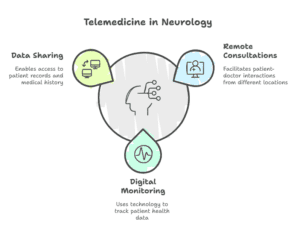Telemedicine has rapidly transformed the landscape of healthcare, offering patients and healthcare providers greater flexibility and access to care. In neurology, where assessments often require specialized care and long wait times, telemedicine has become a game-changer. By enabling remote consultations, virtual follow-ups, and continuous monitoring, telemedicine supports the early diagnosis, treatment, and ongoing management of neurological conditions.
In this article, we will explore how telemedicine supports neurological assessments, improves patient outcomes, and enhances access to specialized care for patients with neurological conditions.
Why Neurological Assessments Matter
Neurological assessments are crucial for diagnosing, managing, and monitoring a wide range of neurological conditions, including:
- Chronic conditions: Disorders such as epilepsy, multiple sclerosis, and Parkinson’s disease require ongoing monitoring and management.
- Acute conditions: Conditions like strokes or traumatic brain injuries need immediate assessment to reduce complications.
- Neurological disorders: Conditions like dementia, Alzheimer’s, and migraines require careful tracking and regular follow-ups.
Timely and accurate neurological assessments are essential for improving treatment outcomes, managing symptoms, and preventing disease progression. Traditional in-person visits may not always be feasible, especially for patients in remote areas, or those with mobility issues. Telemedicine addresses these challenges by providing access to specialized neurological care remotely.
How Telemedicine Enhances Neurological Assessments

1. Remote Consultations with Neurologists
Telemedicine allows patients to consult with neurologists remotely, making it easier to access specialized care without traveling long distances. Key benefits include:
- Convenient access to specialists: Patients in rural or underserved areas can easily access neurologists via video consultations, reducing wait times for appointments.
- Timely consultations: For patients with urgent neurological concerns, telemedicine provides a quick way to connect with specialists, ensuring timely assessments and reducing delays in diagnosis.
- Continuity of care: Telemedicine allows for follow-up consultations, enabling neurologists to monitor the patient’s progress and make necessary adjustments to treatment plans.
2. Virtual Monitoring of Chronic Neurological Conditions
Chronic neurological conditions often require long-term management and monitoring. Telemedicine supports this by enabling continuous, remote monitoring of patients’ conditions. Benefits include:
- Remote monitoring tools: Wearable devices, apps, and home-based monitoring equipment can track vital signs, motor function, and cognitive changes in patients with conditions like Parkinson’s disease or multiple sclerosis.
- Data transmission to specialists: Data from monitoring devices can be transmitted directly to healthcare providers, allowing them to analyze trends and adjust treatments as needed.
- Early detection of changes: Continuous monitoring allows for the early detection of symptom changes or disease progression, enabling timely interventions and reducing complications.
3. Increased Access to Care for Rural Patients
Telemedicine is particularly beneficial for patients living in rural or remote areas who may have limited access to specialized neurological care. How this improves access:
- Breaking geographic barriers: Patients no longer need to travel long distances to see a neurologist, making it easier for them to access the care they need.
- Reducing wait times: Telemedicine helps reduce wait times for appointments, ensuring that patients receive timely neurological assessments.
- Affordable access: Virtual consultations often reduce the cost of care by eliminating travel expenses and the need for in-person visits.
4. Improved Diagnostic Capabilities
Telemedicine enables neurologists to perform a range of diagnostic assessments remotely. Key diagnostic tools include:
- Tele-neurology exams: Neurologists can conduct virtual examinations and assess patients’ symptoms through video calls, asking questions about motor functions, coordination, and cognitive abilities.
- Remote EEGs: In some cases, remote electroencephalograms (EEGs) can be performed, allowing neurologists to assess brain activity and diagnose conditions like epilepsy or seizures.
- Collaboration with local healthcare providers: Telemedicine enables neurologists to work with local healthcare providers to gather information, share diagnostic results, and make treatment decisions without the patient needing to visit the neurologist’s office.
5. Cognitive and Behavioral Assessments
Telemedicine facilitates cognitive and behavioral assessments, especially for conditions like dementia or Alzheimer’s disease. How telemedicine helps:
- Remote cognitive testing: Virtual platforms allow patients to participate in cognitive assessments or memory tests, enabling neurologists to monitor cognitive function and track changes over time.
- Behavioral health support: Telemedicine also supports behavioral health services for patients with neurological conditions, offering therapy or counseling through video or audio calls.
- Family involvement: Telemedicine allows family members to participate in consultations, providing additional support and insight into a patient’s condition and behavior.
6. Telemedicine for Acute Neurological Conditions
Telemedicine also supports the timely management of acute neurological conditions, such as strokes or brain injuries, which require immediate intervention. Benefits for acute conditions include:
- Rapid consultation: Telemedicine enables immediate consultation with a neurologist, even in emergency situations, which can help guide treatment decisions and prevent further damage.
- Tele-stroke care: Some hospitals use telemedicine for remote stroke assessments, allowing neurologists to guide emergency room staff in real-time and administer treatment more effectively.
- Real-time monitoring: For patients who experience sudden neurological changes, telemedicine allows healthcare providers to monitor their condition and offer immediate guidance, potentially reducing the risk of complications.
7. Reducing the Burden on Healthcare Systems
Telemedicine helps reduce the strain on in-person healthcare systems by providing virtual care options that decrease the need for in-office visits. How this benefits the system:
- Increased capacity: Virtual consultations free up in-person resources, allowing healthcare providers to see more patients and improve overall patient access to care.
- Lower costs: Telemedicine reduces the cost of healthcare delivery by cutting down on transportation, infrastructure, and administrative expenses.
- Improved resource management: Telemedicine enables more efficient use of healthcare resources, such as specialist time, which helps improve access to care for all patients.
Conclusion
Telemedicine has significantly improved the way neurological assessments are conducted, making specialized care more accessible, efficient, and cost-effective. By providing remote consultations, continuous monitoring, and the ability to manage both chronic and acute neurological conditions from a distance, telemedicine helps ensure that patients receive timely care and better management of their neurological health. With its many benefits, telemedicine is undoubtedly reshaping the future of neurological care, enhancing patient outcomes, and increasing access to essential services for patients across the globe.
What People Are Asking
1. How does telemedicine support neurological assessments?
Telemedicine allows patients to consult with neurologists remotely, facilitates continuous monitoring of neurological conditions, and provides access to diagnostic tools, improving the overall assessment process.
2. Can telemedicine be used to diagnose neurological conditions?
Yes, telemedicine can be used to conduct virtual neurological exams, monitor symptoms remotely, and analyze data from diagnostic tools such as EEGs, helping with the diagnosis of conditions like epilepsy or Parkinson’s disease.
3. How does telemedicine improve access to neurological care for rural patients?
Telemedicine breaks down geographic barriers, allowing rural patients to access specialized neurological care without the need to travel long distances, thus improving access to timely treatment.
4. What are the benefits of using telemedicine for managing chronic neurological conditions?
Telemedicine allows for remote monitoring, timely interventions, and continuous care management for chronic conditions like Parkinson’s disease and multiple sclerosis, ensuring better patient outcomes.
5. Can telemedicine help with acute neurological conditions like strokes?
Yes, telemedicine enables rapid consultations with neurologists in emergency situations, allowing for timely interventions, such as remote stroke care, which can reduce complications and improve patient outcomes.
Disclaimer
For informational purposes only; not applicable to specific situations.
For tailored support and professional services,
please contact Staffingly, Inc. at (800) 489-5877
Email: support@staffingly.com.
About This Blog: This Blog is brought to you by Staffingly, Inc., a trusted name in healthcare outsourcing. The team of skilled healthcare specialists and content creators is dedicated to improving the quality and efficiency of healthcare services. The team passionate about sharing knowledge through insightful articles, blogs, and other educational resources.
 Book a Demo to Build Your Team Today!
Book a Demo to Build Your Team Today!

 Read Case Studies
Read Case Studies 



 Virtual Medical Assistants
Virtual Medical Assistants



